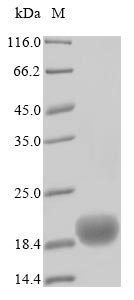The full-length sequence of the mature human CAMPATH-1 (CD52) antigen (25-36aa) is labeled with the 6xHis tag gene aat the N-terminus, obtaining the target gene. The target gene is amplified by PCR. The amplified genes are cloned into expression vectors to construct recombinant plasmids. The recombinant plasmids are transfected into E.coli cells, which are cultured to promote protein expression. Collect the supernatant of the culture medium and purify the supernatant by affinity chromatography to obtain the recombinant human CD52 protein. The purity of the recombinant human CD52 protein exceeds 90% as measured by SDS-PAGE.
Human CD52 is a glycoprotein crucial in the immune system, particularly in the context of lymphocyte biology. It is primarily expressed on the surface of various immune cells, including T cells, B cells, monocytes, and dendritic cells [1][2][3]. CD52 is anchored to the cell membrane via a GPI moiety [3][4]. This glycoprotein is characterized by a short peptide structure comprising 12 amino acids, which is crucial for its biological functions [4][5].
The expression of CD52 is notably high on mature lymphocytes, especially CD4+ T cells, which typically exhibit higher levels than CD8+ T cells [6][7]. CD52 has been shown to modulate T cell activation and proliferation, with soluble forms of CD52 having inhibitory effects on T cells [5][7]. The presence of CD52 on immune cells suggests that it may play a role in cell signaling and interactions during immune responses [5][8]. Furthermore, CD52 is also expressed in certain reproductive tissues, such as epididymal cells and cumulus cells, indicating its potential involvement in reproductive biology [9-11].
References:
[1] S. Karnan, I. Hanamura, A. Ota, S. Takasugi, A. Nakamura, M. Takahashi, et al., Cd52 is a novel target for the treatment of flt3-itd-mutated myeloid leukemia, Cell Death Discovery, vol. 7, no. 1, 2021. https://doi.org/10.1038/s41420-021-00446-8
[2] Y. Cai, Cd52 knockdown inhibits aerobic glycolysis and malignant behavior of nsclc cells through akt signaling pathway, Journal of Cancer, vol. 15, no. 11, p. 3394-3405, 2024. https://doi.org/10.7150/jca.86511
[3] L. Jiang, C. Yuan, J. Hubacheck, J. Janik, W. Wilson, J. Morris, et al., Variable cd52 expression in mature t cell and nk cell malignancies: implications for alemtuzumab therapy, British Journal of Haematology, vol. 145, no. 2, p. 173-179, 2009. https://doi.org/10.1111/j.1365-2141.2009.07606.x
[4] Y. Hu, M. Turner, J. Shields, M. Gale, E. Hutto, B. Roberts, et al., Investigation of the mechanism of action of alemtuzumab in a human cd52 transgenic mouse model, Immunology, vol. 128, no. 2, p. 260-270, 2009. https://doi.org/10.1111/j.1365-2567.2009.03115.x
[5] B. Toh, T. Kyaw, P. Tipping, & A. Bobik, Immune regulation by cd52-expressing cd4 t cells, Cellular and Molecular Immunology, vol. 10, no. 5, p. 379-382, 2013. https://doi.org/10.1038/cmi.2013.35
[6] F. Loeff, J. Falkenburg, L. Hageman, W. Huisman, S. Veld, H. Egmond, et al., High mutation frequency of the piga gene in t cells results in reconstitution of gpi anchor−/cd52− t cells that can give early immune protection after alemtuzumab-based t cell–depleted allogeneic stem cell transplantation, The Journal of Immunology, vol. 200, no. 6, p. 2199-2208, 2018. https://doi.org/10.4049/jimmunol.1701018
[7] F. Vojdeman, S. Herman, N. Kirkby, A. Wiestner, M. Veer, G. Tjønnfjord, et al., Soluble cd52 is an indicator of disease activity in chronic lymphocytic leukemia, Leukemia & Lymphoma, vol. 58, no. 10, p. 2356-2362, 2017. https://doi.org/10.1080/10428194.2017.1285027
[8] W. Huang, X. Zhang, T. Ju, R. Cummings, & L. Wang, Expeditious chemoenzymatic synthesis of cd52 glycopeptide antigens, Organic & Biomolecular Chemistry, vol. 8, no. 22, p. 5224, 2010. https://doi.org/10.1039/c0ob00341g
[9] P. Derr, Y. Ch, T. Cooper, & C. Kirchhoff, Synthesis and glycosylation of cd52, the major 'maturation-associated' antigen of rat spermatozoa, in the cauda epididymidis, Reproduction, vol. 121, no. 3, p. 435-446, 2001. https://doi.org/10.1530/rep.0.1210435
[10] A. Hasegawa, T. Takenobu, H. Kasumi, S. Komori, & K. Koyama, Original article: cd52 is synthesized in cumulus cells and secreted into the cumulus matrix during ovulation, American Journal of Reproductive Immunology, vol. 60, no. 3, p. 187-191, 2008. https://doi.org/10.1111/j.1600-0897.2008.00611.x
[11] V. Giuliani, C. Pandolfi, R. Santucci, F. Pelliccione, B. Macerola, R. Focarelli, et al., Expression of gp20, a human sperm antigen of epididymal origin, is reduced in spermatozoa from subfertile men, Molecular Reproduction and Development, vol. 69, no. 2, p. 235-240, 2004. https://doi.org/10.1002/mrd.20166






